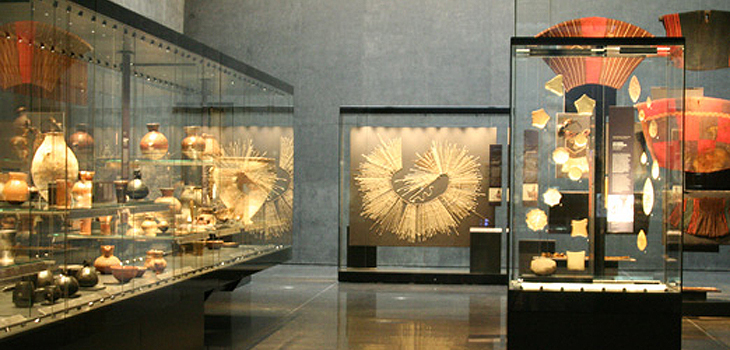
(English below)
Es considerado uno de los mejores museos de Chile, por el valor de su muestra y el concepto museográfico general que exhibe. Su colección está integrada por más de 5.000 piezas en exposición permanente, de diverso origen, pero elegidas con un cuidado criterio estético. La exhibición va más allá del orden cronológico o espacial, presentando en cada vitrina diversas culturas según características estéticas o antropológicas comunes, como el chamanismo, las máscaras o la música. Junto a su invaluable exposición de piezas de culturas americanas, el museo cuenta con una tienda de souvenirs, biblioteca especializada, cafetería, visitas guiadas bilingües, salas de exposición temporal y exposiciones itinerantes para acercar la cultura e historia a la sociedad.
El origen del museo se encuentra en la colección personal de su fundador, Sergio Larraín García-Moreno, arquitecto chileno, que durante 50 años se dedicó a recolectar variados objetos precolombinos. Para velar por la integridad de la colección fue creada la Fundación Familia Larraín Echeñique, que -mediante un convenio con la Ilustre Municipalidad de Santiago- dio vida al Museo Chileno de Arte Precolombino, iniciativa pionera en Latinoamérica.
Hoy, el museo funciona en una de las más importantes edificaciones de la Colonia. De estilo neoclásico, fue construido en 1805 para albergar al Palacio de la Real Aduana durante la administración colonial. Ubicado a una cuadra de la Plaza de Armas, el sitio en que se emplaza este edificio ha ocupado siempre un lugar importante en la historia de Santiago y del país en general.
Esta edificación fue construida sobre planos del arquitecto italiano Joaquín Toesca. Durante la República fue ocupado por la Biblioteca Nacional, y a partir de 1845 se transformó en sede de los Tribunales de Justicia, hasta que en 1968 un incendio destruyó sus instalaciones y archivos. Tras sucesivas obras de recuperación, el museo fue inaugurado el 10 de diciembre de 1981. La Municipalidad de Santiago aportó el inmueble, encargándose de la restauración y acondicionamiento para albergar la exposición.
Su colección se caracteriza por el criterio eminentemente estético por el que se eligieron las piezas, provenientes de diferentes áreas culturales americanas, como ofrendas funerarias de individuos de posición social alta y otros que dan cuenta de diversos aspectos de la vida cotidiana de esas culturas.
(Fuente: Santiago Turismo)

English:
Considered to be one of the best museums in Chile for the value of its exhibits and the overall museographic concept displayed. Its permanent collection includes over 5,000 pieces of various origins, but selected with a careful aesthetic criterion. The exhibit goes beyond chronological or spatial order, with each display cabinet presenting diverse cultures according to aesthetic or anthropological characteristics in common, such as shamanism, masks or music. Besides its invaluable exhibition of pieces from American cultures, the museum has a souvenir shop, a specialized bookshop, coffee shop, guided bilingual tours, temporary exhibition rooms and itinerant exhibitions to draw culture and history closer to society.
The origins of the museum lie in the personal collection of its founder, Sergio Larraín García-Moreno, a Chilean architect who for 50 years devoted himself to collecting a variety of pre-Columbian objects. In order to ensure the integrity of the collection, the Larraín Echeñique Family Foundation was set up; through an agreement with the Town Council of Santiago, this foundation created the Chilean Museum of pre-Columbian Art, a pioneering initiative in Latin America.
Today, the museum operates in one of the most important buildings from the Colonial period. In neo-classical style, it was built in 1805 to house the Royal Customs Palace during the colonial administration. Located one block away from Plaza de Armas, Santiago’s main square, the site on which this building stands has always been an important place in the history of Santiago and of the country as a whole.
This building was erected according to drawings by the Italian architect Joaquín Toesca. During the Republic, it was occupied by the National Library, and from 1845 onwards, it became the seat of the Courts of Justice until a fire destroyed its facilities and archives in 1968. After successive repair works, the museum was officially opened on December 10, 1981. The Municipality of Santiago provided the property, taking responsibility for restoration and conditioning works for it to house the permanent collection.
Its collection is characterized by the eminently aesthetic criteria by which the pieces were chosen, coming from different American cultural areas, as funerary offerings of individuals of high social position and others that account for various aspects of the daily life of those cultures.
(Source: Santiago Turismo)